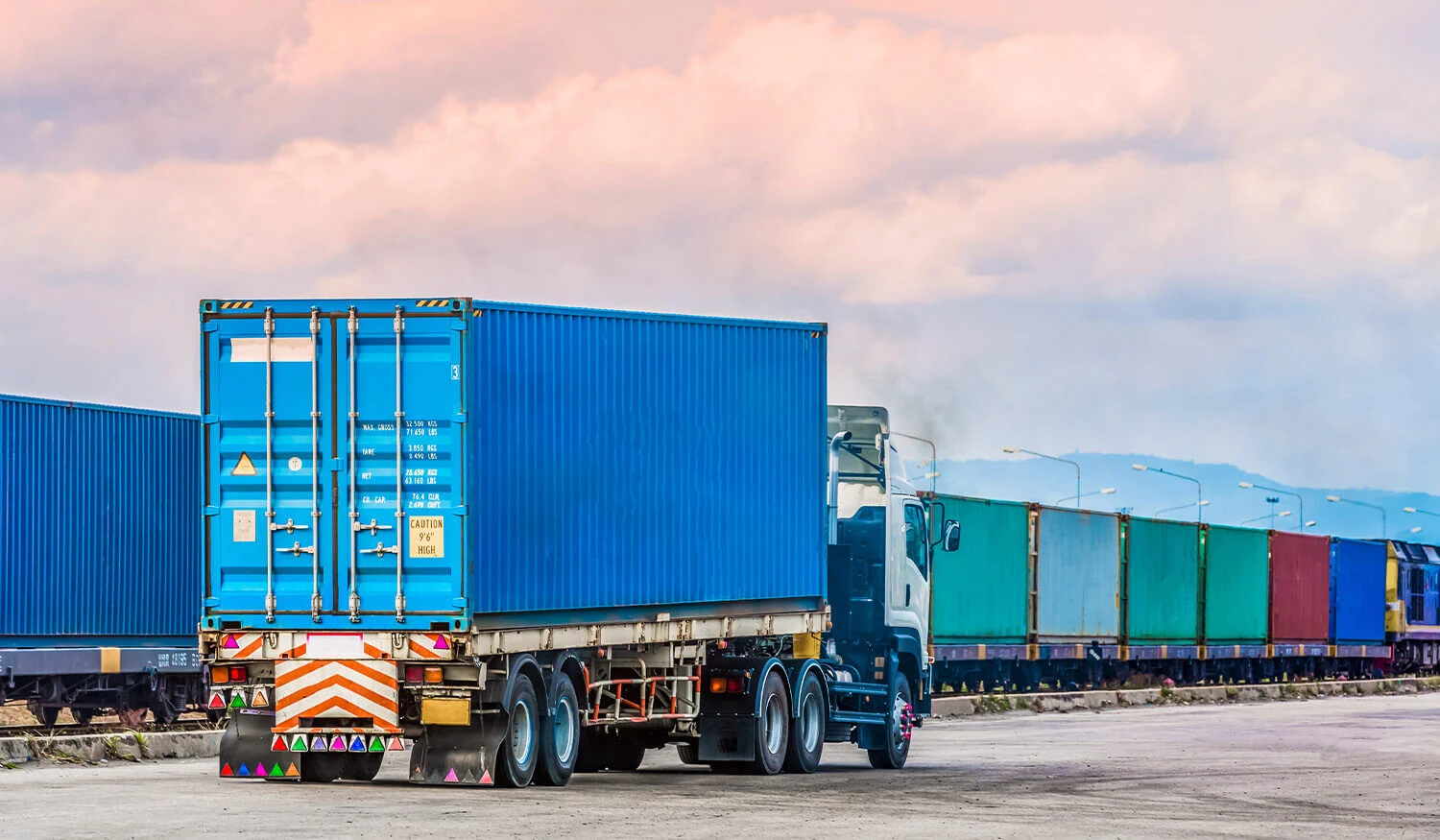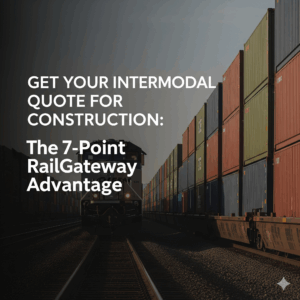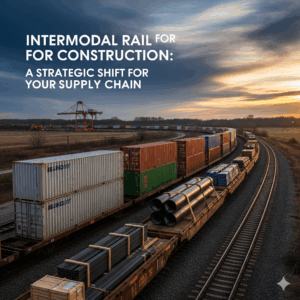Busting the Top 8 Myths of Intermodal Transport in 2025 for Smarter Shipping Decisions
In the fast-paced world of shipping and logistics, staying ahead often means challenging what you think you know. For years, intermodal transport has been surrounded by a fog of misinformation – outdated beliefs, half-truths, and flat-out myths of intermodal transport that shape how companies choose to move goods. Whether you’re managing a regional supply chain or shipping across continents, it’s likely that you’ve encountered some of these common myths of intermodal transport – and they might be costing your business more than you realize.
So, what exactly is intermodal transport? At its core, intermodal shipping involves the movement of goods in a single container using multiple modes of transportation – typically a combination of rail, truck, and sometimes ocean freight – without handling the cargo itself when changing modes. This seamless method of shipping offers significant advantages, especially in terms of cost savings, environmental sustainability, and efficiency. Yet, despite its many strengths, intermodal is often dismissed or overlooked because of persistent myths that no longer reflect today’s realities.
Let’s be clear: logistics has changed. Supply chain strategies are being reevaluated. Shippers are under more pressure than ever to optimize costs, reduce carbon emissions, and mitigate risk across complex networks. And yet, many continue to make choices based on outdated perceptions – particularly when it comes to intermodal shipping. Why? Because the myths of intermodal transport are deeply rooted, frequently repeated, and rarely questioned.
Some believe intermodal is only for the “big players” – mega-retailers or Fortune 500 companies with coast-to-coast operations. Others assume that rail shipping is too slow, unreliable, or rigid to be practical in a modern, just-in-time world. There are concerns about damage, lack of control, hidden fees, and confusing logistics. And many still think that over-the-road (OTR) trucking is always faster and simpler, even when the data says otherwise. These are all common beliefs. But are they actually true?
Spoiler alert: not really.
The truth is, intermodal transportation has evolved – dramatically. Innovations in tracking technology, better infrastructure, improved service coordination between railroads and trucking carriers, and a growing emphasis on sustainability have made intermodal shipping more efficient and accessible than ever before. In fact, for many freight profiles, it’s not just a viable option – it’s the smarter one.
In this blog post, we’re going to shine a light on the most persistent myths of intermodal transport and debunk them one by one. Our goal is to help you see intermodal for what it truly is: a flexible, scalable, and increasingly essential tool in the modern shipper’s toolbox. By exposing the myths, we’ll highlight eight surprising truths that could dramatically shift your approach to logistics – whether you’re managing domestic freight, working with third-party logistics (3PL) providers, or reevaluating your company’s carbon footprint.
You might be wondering why these myths are still so prevalent. The answer lies in a mix of legacy thinking, regional limitations, and sometimes just plain misinformation. Trucking is deeply ingrained in North American logistics, and for good reason – it’s fast, direct, and deeply understood by most logistics professionals. But intermodal isn’t here to replace trucking; it’s here to complement it. In fact, the very design of intermodal is built on integration, using each mode of transport where it performs best. Rail handles the long haul efficiently and affordably, while trucks manage the first and last mile with agility. When done right, it’s a partnership – not a compromise.
What makes these myths of intermodal transport so sticky is that they often start with a kernel of truth – something that may have been accurate a decade ago, but no longer reflects today’s capabilities. For example, while rail transit was once synonymous with inflexibility, modern intermodal solutions offer more scheduling options and far more reliable service levels. Similarly, concerns about shipment visibility may have been valid in the past, but current GPS tracking, EDI integrations, and real-time data sharing have transformed the customer experience.
Of course, intermodal isn’t a one-size-fits-all answer. No shipping solution is. It’s most effective when used strategically – for medium to long-haul lanes, for commodities that don’t require lightning-fast delivery, and for companies looking to scale efficiently. The key is knowing when and how to use it, and that starts with understanding what it is – and what it is not.
In today’s shifting economic landscape, where transportation costs are under the microscope and businesses are being asked to do more with less, ignoring intermodal as an option could mean missing out on meaningful cost savings, enhanced reliability, and a more sustainable footprint. As the freight market continues to evolve – driven by consumer expectations, regulatory pressures, and supply chain resiliency – shippers need to base decisions on facts, not fear or fiction.
That’s why we created this guide.
In the sections that follow, we’ll walk you through the eight most common myths of intermodal transport – from the belief that it’s always slower or more complicated, to the assumption that you lose visibility or control. We’ll back each one with data, examples, and insight from logistics experts. And by the end, we hope you’ll see intermodal not just as an alternative, but as a competitive advantage – one you can start leveraging immediately.
Whether you’re an operations manager trying to hit KPIs, a supply chain director navigating tightening budgets, or a business owner looking to scale, it’s time to revisit what you think you know. The myths of intermodal transport don’t hold up under scrutiny – and once you see through them, you’ll be empowered to make smarter, more strategic shipping choices.
Let’s dive in.

Common Myths Of Intermodal Transport
Here are some questions and myths of intermodal transportation, let’s dive into it –
Is Intermodal Slower Than Trucking?
It might seem counterintuitive, but intermodal shipping can often be faster than traditional trucking, especially for long distances. While local truck shipments might take a couple of days, rail shipments can cover hundreds of miles in a similar timeframe. This is because trains face fewer delays compared to trucks, which can get stuck in traffic or encounter other roadblocks.
Is Intermodal Less Reliable Than Trucking?
With advancements in technology and infrastructure, intermodal shipping has become increasingly reliable. In fact, many intermodal services boast on-time delivery rates of well over 90%. This reliability is due to factors like improved rail lines, advanced transportation management systems, and more efficient equipment.
Does Intermodal Transportation Have More Complicated Box Options?
Another one of the myths of intermodal transport is some people think that intermodal containers are too small for their products. However, this is often a misconception. While international shipping containers are typically 20 or 40 feet, there are also 53-foot domestic containers that are specifically designed for land transportation in the United States, Canada, and Mexico. For more information on intermodal container sizes, you can refer to the provided link.
Does Intermodal Transportation Increase the Risk of Damage?
Proper packaging and loading procedures can help minimize damage risks in both intermodal and trucking shipments. While smaller shipments might require extra care during loading into rail containers, experienced intermodal companies have the expertise to handle such situations. Overall, the risk of damage is comparable between the two modes.

Is Intermodal Transportation More Complicated?
The myths of intermodal transport are complicated is often outdated. With the rise of freight forwarders offering all-inclusive services, the process has become much simpler. These services handle everything from drayage to line haul and tracking, eliminating the need for you to coordinate multiple carriers. This can significantly reduce the headaches associated with traditional trucking shipments.
Is Intermodal Transportation Less Secure?
Another one of the myths of intermodal transport is that intermodal shipping is actually safer than trucking in many ways. Trucks drive on roads where anyone can see them and try to do bad things. But trains go on special tracks that are not open to everyone. This makes it harder for bad guys to steal things from trains. If you’re shipping something really valuable, intermodal might be a better choice. You can even ask for your stuff to be put in a special place on the train where no one can open the doors. This extra safety can give you peace of mind.
Does Intermodal Have Weight Issues?
Intermodal weight can be a complex issue for shippers. As, the maximum weight allowed for a domestic intermodal container is typically 59,000 pounds, which is much higher than the limit for over-the-road (OTR) shipments. However, this is just the beginning.
To ensure legal shipments, it is essential to follow weight restrictions on steer and axles. Additionally, shippers new to intermodal should familiarize themselves with “harmonic vibration,” a gentle vibration that can affect freight placement within containers.
Does Intermodal Shipping Have No Competition?
One of the common myths of intermodal transport is that railroads don’t need to try harder because there aren’t many other options and competition. But there are still a few different railroads to choose from, and they’re all trying to get customers who used to use trucks. And, to do this, they’re working with trucking companies to offer a mix of truck and train services that are faster, more flexible, and cheaper.
Conclusion
Now that we’ve unpacked the myths of intermodal transport, one thing should be clear: many of the most common objections to intermodal shipping are not grounded in current realities. They are relics of a past that no longer reflects how intermodal transportation actually works today. From outdated assumptions about speed and reliability to lingering fears around complexity and visibility, these myths persist because they’re comfortable and familiar – not because they’re true.
But for shippers who are willing to look past these misconceptions, intermodal transport opens the door to new possibilities. It offers a path toward greater operational efficiency, lower freight costs, and a significantly reduced carbon footprint. In a global market where logistics challenges are growing more complex – and where supply chain resilience is a top strategic priority – ignoring intermodal options could mean falling behind.
The myths of intermodal transport aren’t just misleading; they’re actively holding businesses back from better performance. And in a time when every dollar matters and every shipment counts, clearing away those myths is not just helpful – it’s essential.
The Real Cost of Believing Myths of Intermodal Transport
Believing the myths of intermodal transport can have real consequences. Let’s recap what’s at stake when companies let outdated assumptions guide their shipping decisions:
- Higher freight costs: Many shippers continue using full truckload (FTL) services for long hauls without comparing total landed costs. In many cases, intermodal can offer the same service quality at a significantly lower rate.
- Reduced supply chain sustainability: Intermodal transport – especially rail – generates far fewer emissions than trucking alone. Failing to incorporate it limits your ability to meet internal sustainability goals and external compliance standards.
- Missed scalability opportunities: Intermodal is designed for repeatable, high-volume lanes. For growing companies, it’s one of the most scalable, consistent solutions available. Believing it’s only for “big business” is a costly myth.
- Lack of resilience: Diversifying your mode strategy can protect you against market fluctuations, fuel price volatility, and driver shortages. Relying on a single transport mode makes your operation more vulnerable to disruption.
The truth is that many companies simply haven’t reevaluated their transportation strategy in years. They’re still operating under assumptions that were formed a decade ago – before technology improved tracking, before Class I railroads modernized operations, and before climate impact became a boardroom-level discussion.
If that sounds familiar, you’re not alone. But change starts with information – and now you have it.
The Myths of Intermodal Transport vs. the Modern Reality
Let’s take a final look at how the myths of intermodal transport stack up against the current truth:
| Myth | Modern Reality |
| Intermodal is too slow | Rail transit times are now highly predictable and can match OTR in many lanes. |
| It’s only for large enterprises | Intermodal is available to mid-sized and small shippers through 3PLs and IMCs. |
| You lose visibility and control | Real-time tracking, EDI, and API integrations now offer full shipment visibility. |
| It’s complicated to manage | Modern TMS platforms and logistics providers make intermodal simple and seamless. |
| Risk of damage is higher | Containers are sealed, handled less, and protected throughout the journey. |
| It doesn’t work for high-value goods | Secure, temperature-controlled, and monitored solutions are widely available. |
| It’s only for certain commodities | From food and beverage to consumer goods and electronics, intermodal is versatile. |
| It’s not flexible enough | Flexible routing and scheduling options have vastly improved. |
These aren’t just minor corrections—they represent a total shift in thinking. Shippers who embrace this reality will be better positioned to control costs, improve reliability, and build a supply chain that’s ready for what’s next.
Intermodal as a Strategic Advantage
Once you look past the myths of intermodal transport, what you’re left with is a strategic opportunity.
Modern intermodal is more than just a niche option or a backup plan. It’s a mainstream, technology-enabled, sustainability-forward mode that allows you to combine the strengths of rail and truck into one optimized shipping solution. For the right freight profiles, intermodal is not a compromise – it’s a competitive advantage.
Want to reduce costs on high-volume, long-haul lanes? Intermodal should be in your mix.
Want to reduce your Scope 3 emissions? Intermodal is one of the lowest-emission modes available.
Want to build a more diversified and resilient shipping network? Intermodal helps you do that, too.
And the best part? You don’t have to figure it all out on your own. Most 3PLs and intermodal marketing companies (IMCs) specialize in helping businesses make the transition to intermodal smooth, simple, and aligned with your supply chain strategy.
What Shippers Should Do Next to Break the Myths of Intermodal Transport
If this post has challenged your thinking about intermodal shipping, that’s a good thing. The next step is putting that insight into action. Here’s how to start moving past the myths of intermodal transport and into smarter decision-making:
- Audit your freight lanes: Identify regular long-haul shipments that may be good candidates for intermodal. Volumes over 500 miles are often ideal.
- Talk to your 3PL or carrier: Ask what intermodal options are available in your current network—and what technology supports are included.
- Compare total landed costs: Don’t just compare rates. Include fuel surcharges, accessorials, dwell time, and carbon costs in your analysis.
- Pilot a single lane: Run a test on a low-risk lane to evaluate service levels, transit time, and visibility performance.
- Monitor performance data: Use KPIs like on-time delivery, cost per mile, and emissions per ton to evaluate impact.
- Educate your team: Make sure internal stakeholders understand what intermodal is – and what it isn’t.
By proactively challenging the myths of intermodal transport within your organization, you create space for better logistics performance across the board.
Final Thoughts: Break the Myths of Intermodal Transport, Ship Smarter
Logistics doesn’t stand still. Neither should your assumptions.
The myths of intermodal transport have lingered for too long, shaping decisions with outdated logic and causing businesses to overlook one of the most strategic tools available in modern shipping. But you now know better. You’ve seen the real picture. And with that clarity comes the power to act – smarter, faster, and with more confidence.
As freight markets continue to shift, the companies that succeed will be those willing to challenge the status quo, rethink entrenched beliefs, and adopt forward-looking shipping strategies. Intermodal isn’t the future – it’s the present. And it’s time to embrace it.
Don’t let the myths of intermodal transport define your supply chain. Let truth, strategy, and efficiency lead the way.
Break the myths of intermodal transport. Ship smarter. Go intermodal. Contact RailGateway today for a quote or to speak with one of our Experts!

Additional Resources
Association of American Railroads (AAR) – Freight Rail & Intermodal
https://www.aar.org/issue/freight-rail-intermodal/
Explains how intermodal shipping works and its role in modern logistics, helping debunk myths about inefficiency and delays.
Transport Canada – Rail Transportation
https://tc.canada.ca/en/rail-transportation
Outlines the regulatory framework and safety of rail in Canada, supporting the reliability and compliance of intermodal transport.
Railway Association of Canada – Intermodal Freight
https://www.railcan.ca/industry/intermodal/
Covers the benefits of intermodal rail and clears up misconceptions around speed, environmental impact, and infrastructure.
Canadian National Railway (CN) – Intermodal Services
https://www.cn.ca/en/our-services/intermodal/
Details CN’s intermodal capabilities, providing proof of modern, tech-enabled logistics solutions and real-time tracking
How We Can Help
For businesses looking to optimize their freight shipping with reliable, efficient, and cost-effective solutions, RailGateway.ca is your trusted partner in intermodal logistics. Whether you’re new to freight trains or want to enhance your existing supply chain, our team of intermodal experts is ready to guide you every step of the way.
Contact RailGateway.ca today for a free quote or to speak directly with one of our experienced intermodal specialists. Let us help you unlock smarter, smoother shipping solutions tailored to your unique needs.
Visit RailGateway.ca or call us to get started on transforming your freight shipping strategy in 2025 and beyond.





